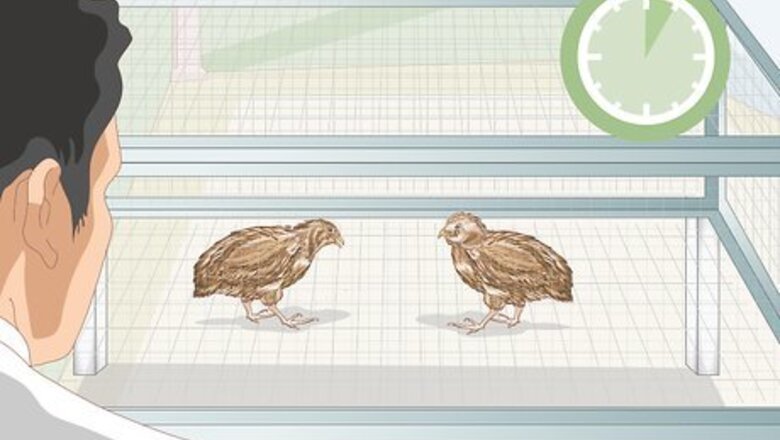
views
- Changes in a quail’s energy levels, plumage, eating habits, droppings, or general behavior may all be signs that they’re feeling under the weather.
- Ulcerative enteritis is one of the most common reasons that quails die young; the big symptoms include dropped wings, a “fluffy” appearance, lethargy, and changes to their coloration.
- If your quail has excessive snot around their beak and eyes, swelling, or difficulty breathing, they may have coryza—an infectious bacterium that can be deadly for quail.
- Respiratory infections are common in quail, especially when they’re kept in close quarters and small enclosures; common symptoms include excessive snot, rattled breathing, listlessness, diarrhea, and slowed-down egg production.
- Worms, mites, and other parasites are all common with quails, and skin irritation, feather loss, eating issues, and changes in droppings are all potential symptoms.
Watching for Behavioral Signs
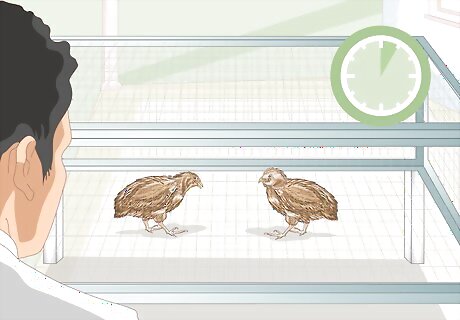
Observe the enclosure for quarter of an hour. Quail that are healthy tend to move around a lot during the day. Quail that are weak or ill will conserve their energy and huddle into the corner of the pen. This is known as lethargy, and is a common symptom for a variety of health issues. Look for changes in your quails' behaviour, such as a decrease in appetite, isolation from the flock, or irritation.
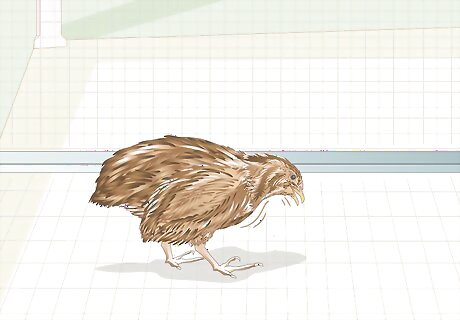
Look for excessive panting. Panting that is accompanied with wings drawn out from the body is a sign of over exposure to heat. Whilst this does not mean that your quail is sick, overheating can lead to some detrimental health consequences. It's important to cool your quail down immediately if you spot these behavioural signs. Panting can also be due to dehydration. Ensure your quail have easy access to fresh cold water at all times during the day and night.
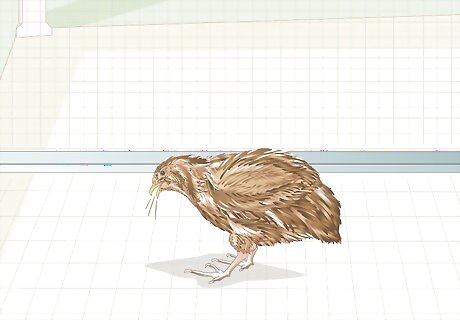
Listen for signs of coughing, sneezing or wheezing. Causes of these symptoms could be a bacterial infection in the upper respiratory tract, such as Bronchitis. Most breeds of quail, including Coturnix quail, are resistant to bronchitis. However, this respiratory issue is known to exhibit in Bobwhite quail.
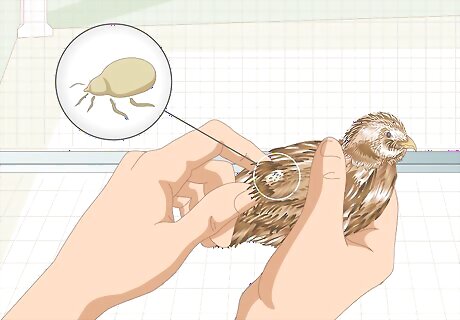
Examine your quail for mites. Persistent itching, restlessness and feather loss is a common symptom for mites, but fortunately can easily be treated and is fairly common.
Looking for Physical Changes
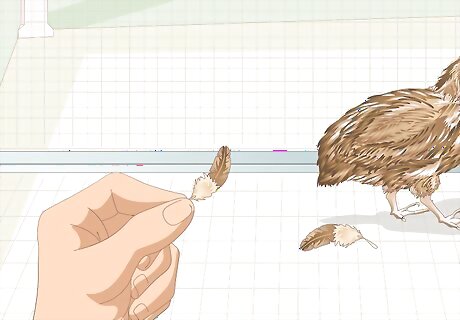
Look for feather loss. Moulting and bald spots are general signs of stress or illness, or could be a result from an attack. On a contrary; certain breeds of quail will moult naturally twice a year, such as the Coturnix quail. Feather plucking is also provoked by birds that suffer from malnutrition or mites. For more information, visit our article How to Treat Feather Loss in Quail
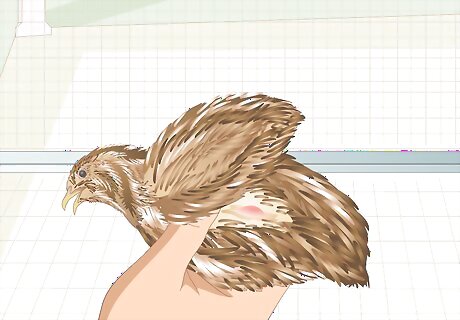
Check for wounds, patches and abnormal lumps. Sores, wounds, scrapes or bumps are susceptible to infection if not medically treated. While these symptoms range from severity, they can generally be healed at home using antibacterial cream and a wound cleanser. Visit our wikiHow article How to Care for a Wounded Quail for more instructions on how to look after your quail.
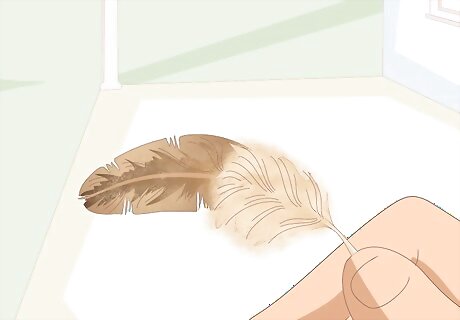
Examine your quails' feathers. It's not abnormal for feathers to look dull in colour or lie differently when your bird is sick. Fluffed up feathers indicate that your quail is cold, and is conserving heat and energy due to illness. Ragged feathers are another symptom, as your quail may not have enough energy to preen themselves. Quail fluff up feathers naturally when they are asleep. This does not mean they are ill. Fluffed up feathers is generally a response to a variety of health problems.
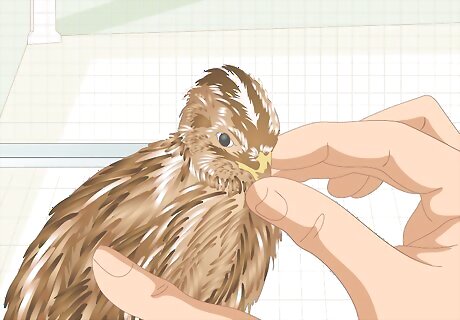
Study your quails' eyes and nostrils for mucous or discharge. Your quail's eyes should appear to be clear and clean around the eyelid area, as should their nostrils. If there is fluid coming from the eyes or nostrils, this could indicate an illness. Cloudy eyes are also another symptom of disease.
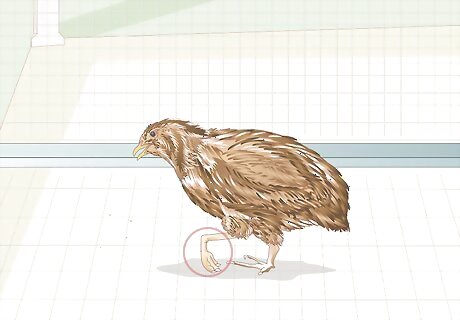
Observe your quail's movement. If your quail is moving abnormally from the rest of the flock, such as limping or struggling to walk, they may have an injured foot. Examine the bottom of your quail's foot for bumblefoot, or around the leg for any sprain, wound or blood.
Looking for Dietary Changes
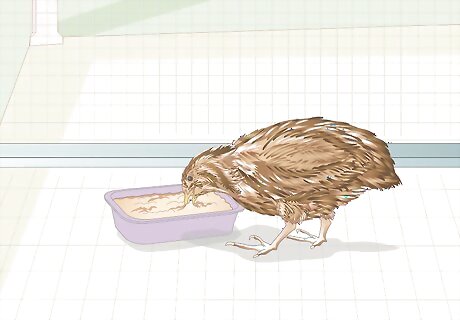
Pay attention to how much food your quail eats. Quail are ground-dwelling foragers, meaning that they need to eat constantly throughout the day as part of their dietary upkeep. Ensure that your quail is successfully eating both their pellets, and pecking at grit and bugs on the ground. If your quail hangs back during feeding time, they could be ill. Refusal to eat or drink is a common symptom of disease.
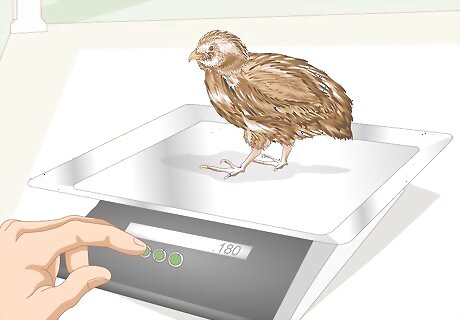
Weigh your quail daily. While this may seem like a lot of work, a drastic decline in weight is one of the most obvious signs of health problems. Weigh your quail at the same time every day to avoid fluctuation due to meal times. If your quail's weight suddenly drops by 10%, you should immediately organize a check up with your veterinarian. Use a scale that measures in grams, not kilograms, such as a kitchen scale.
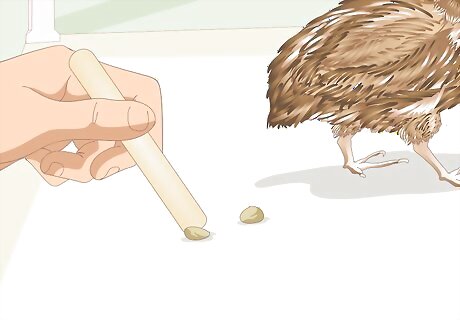
Examine your quails' droppings. Quail droppings are brown in colour and quite firm. They may sometimes exhibit white streaks or light brown spots. Yellow and bright green droppings are abnormal, and could be a sign of a digestive issue. Runny droppings, or droppings that cause matting around the feathers of the quails cloaca are signs of diarrhea. Diarrhea is a common digestive issue involving coccidiosis, or malnutrition. Blood and mucous may be present in droppings of quail that have a bacterial infection. It's important to take your quail to a veterinarian as soon as possible if you spot such symptoms.
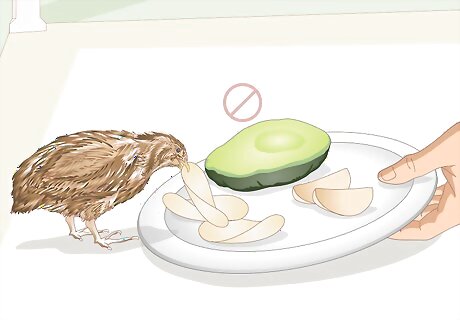
Monitor treats and table scraps that are fed to your quail. Some vegetables and human foods can cause digestive problems due to the amount of salt, sugar or acidity that they contain. For example, avocados and raw potatoes are toxic to many species of birds. Human foods such as chocolate, crisps, and candy are also unhealthy and can upset your quail's gut. While foods such as iceberg lettuce and watermelon aren't necessarily poisonous, they contain a lot of water and can cause diarrhea and bloating.

Notice if there is a decline in egg production. Your quail should be laying eggs 4-5 times a week. When ill, your quail may have trouble laying, or lay a misshapen egg. If you notice your quail has stopped laying eggs suddenly, she could possibly be egg bound.
Treating Health issues
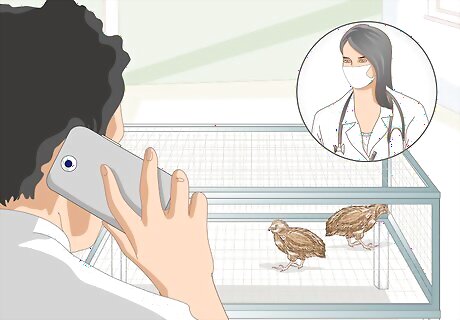
Book a consultation with an experienced avian vet. Like most birds, quail are notorious for hiding their symptoms until it is too late. This is so that they aren't detected as easy food for prey in the wild, or so that they aren't isolated from their flock. If you spot any symptoms that could be an underlying cause of a health issue, it's important to consult with a veterinarian as soon as possible. If you do not act fast, it could cost you your quails' life. A typical veterinarian consult or check up will cost around $30 US dollars, depending on where you are located. However, prices can range up to $60 US dollars, so it is important to have a vet fund available for such cases of an emergency.
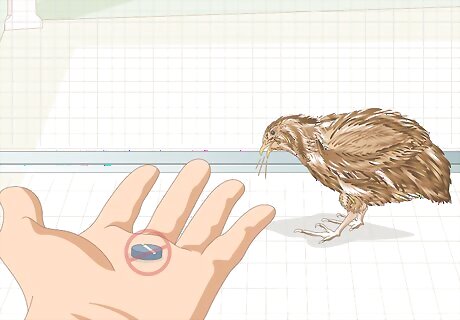
Do not treat symptoms if you do not know the cause. Wounds, mites, malnutrition and dehydration are an exception. Any other illness, disease or health issue will require serious medical attention, and needs to be professionally diagnosed by a vet.
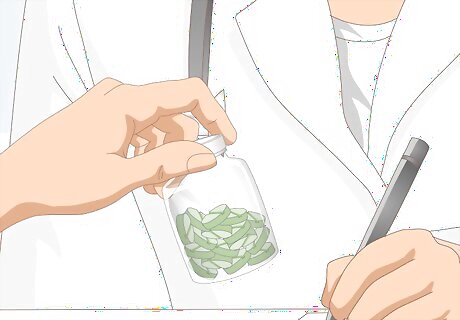
Purchase medication from a vet clinic or pet store. Many illnesses and infections will need treatment via medication. Some forms of medicine may be available at local pet stores, while others will need to be prescribed by your vet. Do not give your quail medication or antibiotics unless advised by a veterinarian.

Make an emergency protein mash for quail that refuse to eat. Soak game-bird pellets in lukewarm water and add cooked scrambled eggs with soaked finch seed. If you cannot obtain game-bird feed with 20% protein, you can purchase either chick starter with 20% protein, or a turkey mash that contains 24% - 26% protein. You will need to hand-feed your quail with a syringe if they are incapable of eating on their own. You can purchase emergency food for quail or baby chicks from pet stores, livestock feed stores, or from a vet clinic. Quail require around 20% of protein in their regular game-bird feed. Do not be afraid to increase their protein intake when they are ill or struggling to consume food.

Transfer your quail to a temporary home. It's important that you separate any unwell or injured quail from the rest of the flock to prevent bullying or contamination. You will want to keep your quail close by so that you can monitor their behaviour and any changes in their health. A small cardboard box or shoe box lined with newspaper and an old white towel will be adequate. Their home does not need to be spacious, as your quail will only be staying there shortly. Ensure that the box has a lid to keep their home dark and quiet to lower stress levels in the environment. Place your quails' home in a quiet, yet warm, space in the house, such as your bedroom. Place a heating pad set to a low temperature inside of the box to keep your quail warm. Otherwise you can use a hot water bottled wrapped around a towel.

Create a DIY first aid kit. Pack a small bag with antibiotics, antibacterial cream, bandages, wound cleanser and an emergency food kit for cases of an emergency.
Preventing Health Issues
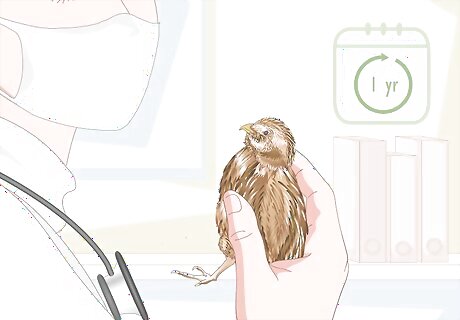
Organize a check-up with veterinarian once a year. Symptoms of illness, infection or injury can be quite hard to diagnose on your own. It can be difficult for families to know when their guinea pig is sick. This is why it's suggested to have your guinea pig checked annually by an experienced exotic vet. Additionally, they will be able to tell you if your guinea pig is overweight, underweight, receiving enough nutrients, or have an abscess or lump you may not know about.
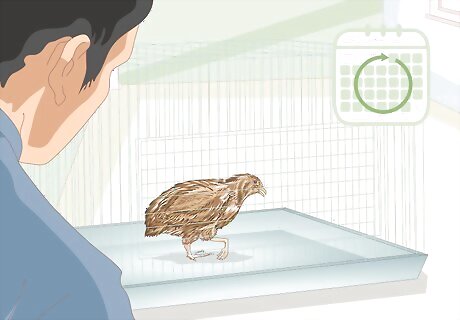
Examine your quail daily. Changes in behaviour, weight or appearance can happen suddenly or overnight. While some veterinarians will advise to check your quail weekly, it's also suggested to examine your guinea pig day by day to catch any changes as soon as they happen.
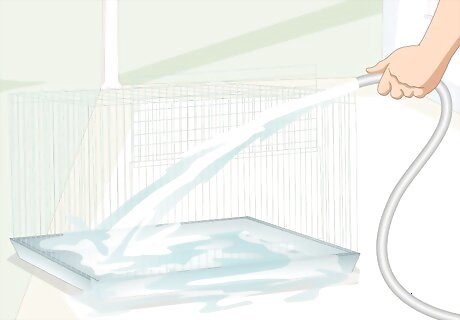
Clean their cage frequently. Quail droppings are high in ammonia, and can cause respiratory issues, bumblefoot and unhygienic infections if not cleaned properly on a frequent basis. Spot clean every day, and deep clean every week as a minimum. Most farmers keep their quail in cages hung above-ground with wire flooring to allow waste to drop to the bottom and keep the base of the cage clean. While this saves you time and effort, you will have to keep the spacings in the wire quite small to ensure the comfort of your quail.
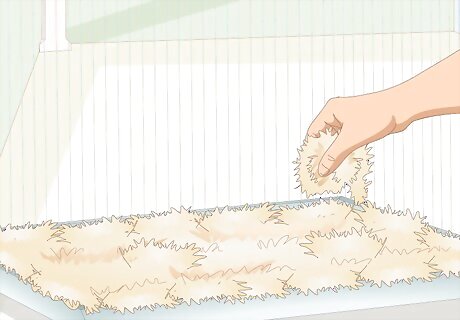
Switch to an absorbent bedding. It's important to use an absorbent yet comfortable bedding in your quails' enclosure for hygiene purposes. Line the floor of your enclosure with newspaper or puppy pads, and add wood shavings or paper bedding (shredded paper). Do not use cedar wood shavings, as these can cause respiratory issues. Aspen shavings are the safest to use on animals, as are kiln-dried pine shavings.
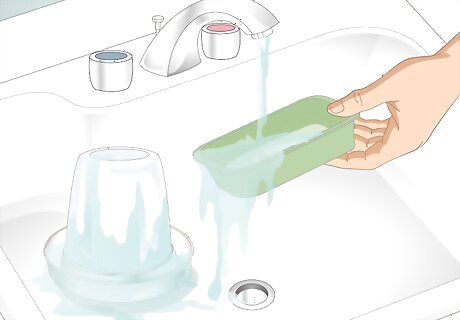
Clean the food and water bowls regularly. If you currently use water or food bowls, consider switching to a feeder or drinker, otherwise use nipple waterers. These will keep the water and food cleaner for longer, and prevent your quail from stepping or sleeping inside the bowl. Quail require fresh, clean water and food every day to prevent contamination of disease.

Quarantine new quail before adding to an existing flock. Birds purchased from foreign farms or markets have an increased risk of carrying disease. However, these symptoms may not be evident until at least a couple of weeks of housing your quail in solitary confinement. Do not introduce new birds to an existing flock until you are sure they are healthy and illness-free. Additionally, it is advised by breeders and farmers to incubate your own eggs to avoid risk of bacterial or parasitic contamination.
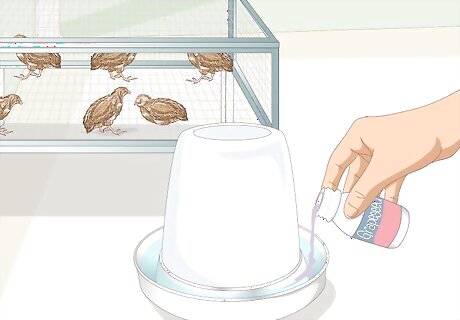
Add a natural antibiotic to your quails' water if advised by a vet. Citrocidal is a natural antibiotic made from grape seeds that can be added to the water to prevent respiratory difficulties such as coughing, sneezing, or rasping breathing. However, do not add anything to your quails water unless advised by a vet, as your quail may refuse to drink their water if they disfavour the taste.















Comments
0 comment